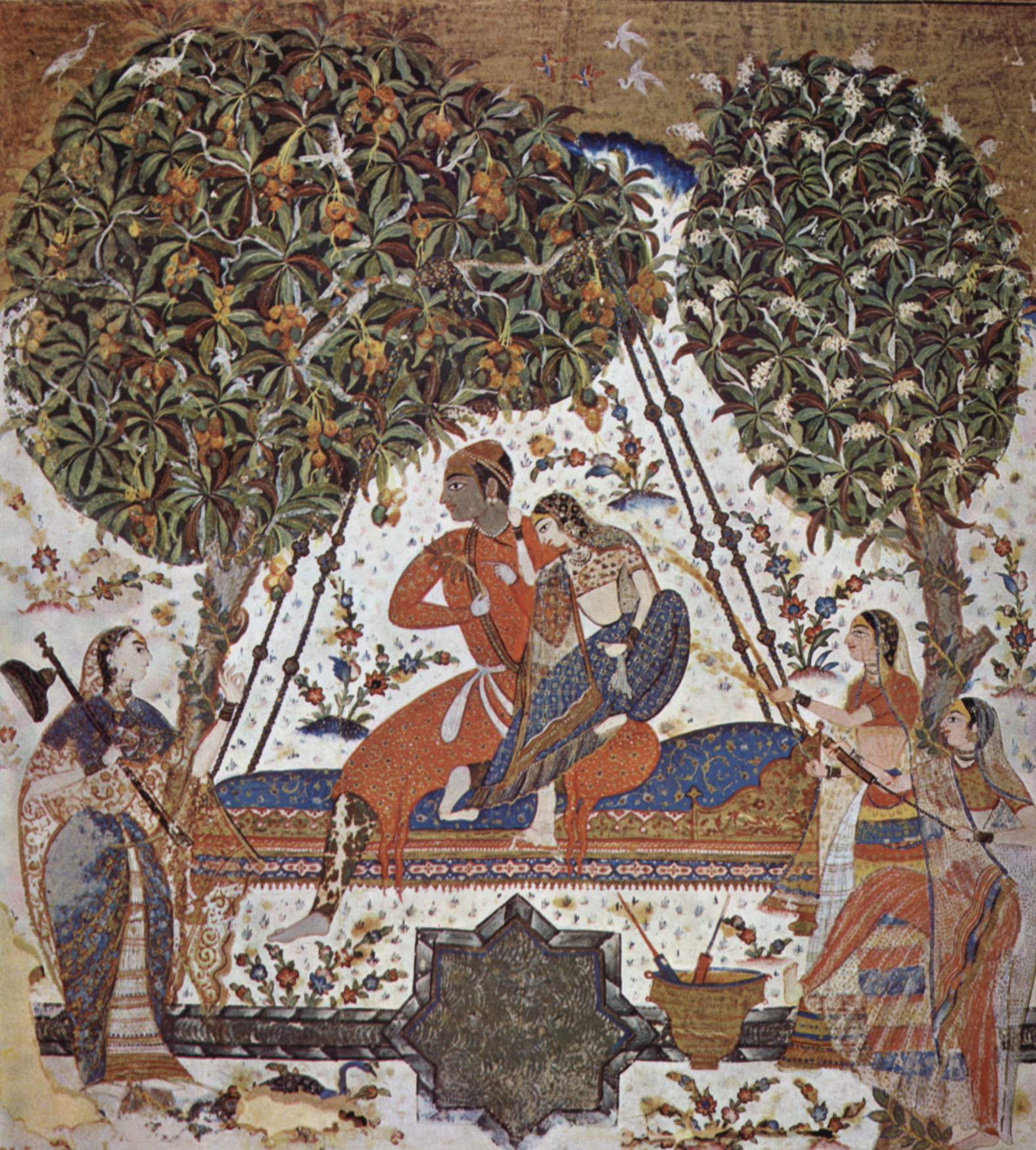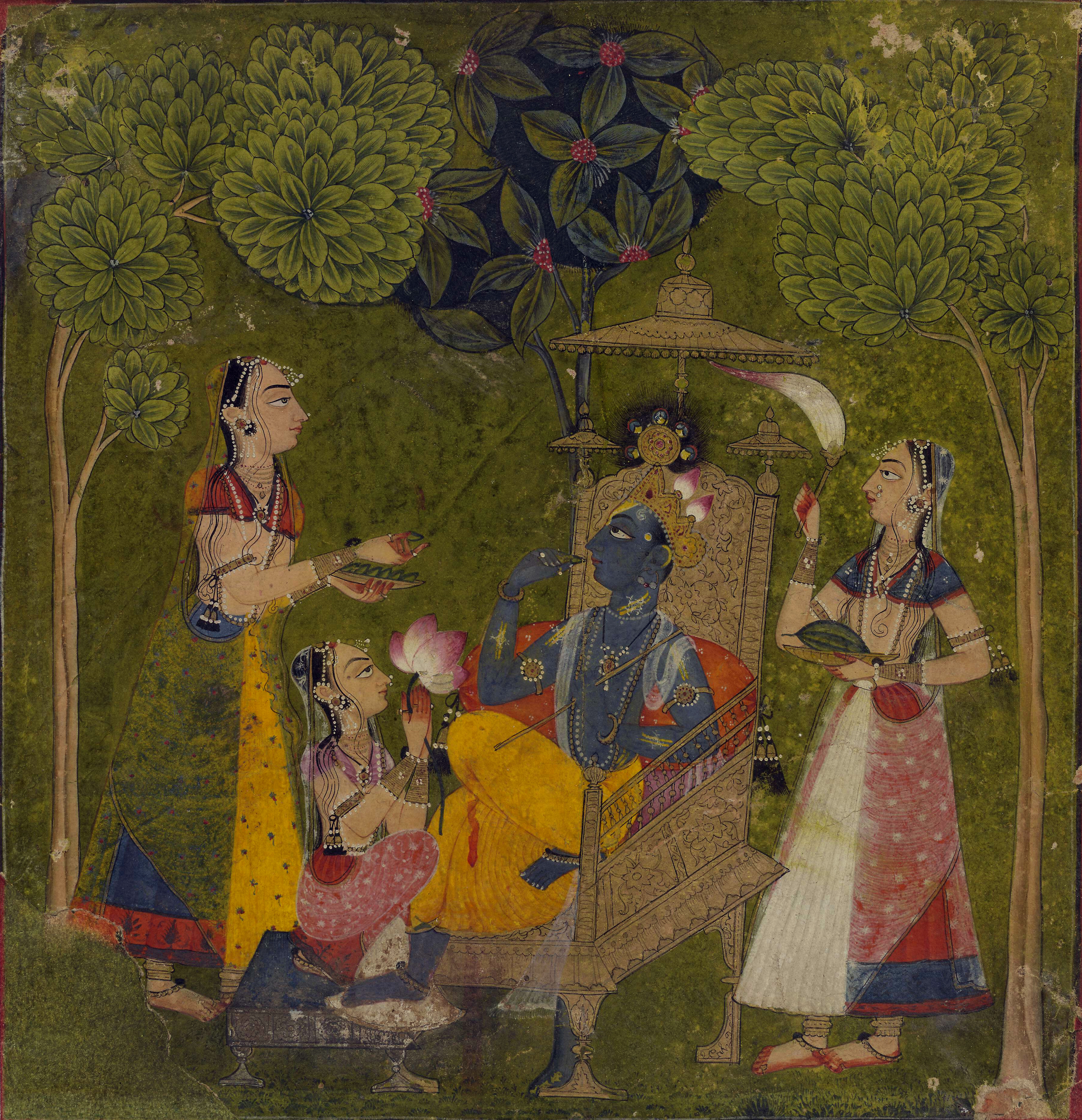 |
| Malavakusika Raga, Rajasthan, India Metropolitan Museum of Art, CC0, via Wikimedia Commons |
Introduction: Where Music Meets Painting
Among the most profound and aesthetically engaging genres of Indian miniature painting is the Ragmala series. “Ragmala” literally translates to “garland of ragas,” a poetic metaphor for how paintings were linked to the musical modes of Indian classical music.
These paintings were not simple illustrations; they were visual interpretations of sound, mood, and poetry, transforming the intangible essence of music into vibrant color and form.
Created in Rajasthan, the Deccan, and the Punjab Hills between the 16th and 19th centuries, Ragmala paintings represent a rare synthesis of the arts in India—music, poetry, and painting bound together as facets of a unified cultural expression. They are not only artistic treasures but also windows into how Indians of the past experienced art as a multi-sensory phenomenon.
What is a Ragmala? Understanding the Concept
In Indian classical tradition, a raga is not merely a melody or scale—it is a musical mode rich with symbolic and emotional associations. Each raga is tied to:
-
A specific time of day (dawn, dusk, midnight).
-
A season (spring, monsoon, summer, winter).
-
A mood or emotion (love, longing, devotion, heroism).
-
A gendered persona (male ragas and female raginis).
The Ragmala paintings personified these ragas into human characters, natural landscapes, and symbolic elements. For example:
-
Megh Malhar Raga (monsoon raga) shows clouds, rain, and peacocks, evoking romance in the rainy season.
-
Dipaka Raga (fire raga) is depicted with lamps, flames, and summer heat, symbolizing intensity.
-
Vasanta Raga (spring raga) features blossoming flowers and lovers in gardens, embodying joy and renewal.
Thus, Ragmala paintings allowed viewers to “see the music” and to experience the emotional resonance of sound through sight.
Themes and Subjects in Ragmala Paintings
The heart of Ragmala art lies in its narrative richness. These paintings rarely depicted abstract patterns; instead, they created scenes filled with human drama and symbolism, often revolving around love, devotion, and nature.
1. Lovers and Longing: The Nayaka–Nayika Archetypes
 |
| Vasanta Raga National Museum, Public domain, via Wikimedia Commons |
A central theme in many Ragmala paintings is the exploration of romantic love, expressed through the imagery of the nayaka (hero) and nayika (heroine).
These archetypal figures embody different shades of shringara rasa—the aesthetic of love and desire—that dominated classical Indian art and literature. Each raga was imagined as a character in a narrative of longing, union, or separation, giving painters a wide range of emotional tones to depict.
The nayika is often shown in various emotional states. She may be the Virahini, the woman pining for her absent beloved, gazing at the moon or confiding in her attendants.
At other times, she appears as the Abhisarika, braving the dangers of night, lightning, and storm clouds as she hurries through the forest to meet her lover. She might also be the Vasakasajja, adorning herself with jewels and flowers, her chamber prepared in anticipation of union. Each variation reveals a different mood, reinforcing how music could evoke nuanced emotional landscapes.
The nayaka, too, appears in different roles—sometimes as the passionate lover arriving on horseback, sometimes as the aloof figure whose absence creates longing. The natural surroundings—flowering gardens, moonlit terraces, or turbulent monsoon skies—mirror the emotions of the lovers.
Through these delicate portrayals, Ragmala artists transformed music into visual poetry, showing love not only as passion but as a deeply symbolic expression of the human condition.
2. Nature as an Emotional Mirror
Landscapes in Ragmala paintings are more than backgrounds—they reflect the emotional states of the characters.
-
Peacocks and lightning symbolize monsoon passion.
-
Lotus ponds suggest purity and blossoming love.
-
Storm clouds embody longing and intensity.
-
Moonlit nights echo themes of separation or secret romance.
Through this fusion of human and natural imagery, Ragmala artists created emotional landscapes that harmonized with the raga’s essence.
3. Devotion and Spirituality
 |
| Lord Krishna With Milkmaid Devotees British Museum , Public domain, via Wikimedia Commons |
These paintings highlighted the bhakti (devotion) that lay at the heart of Indian cultural life. Figures were often shown in acts of worship, prayer, or meditative solitude, suggesting that ragas could be pathways not only to human emotion but also to spiritual transcendence.
In such paintings, the central figure might be Lord Krishna, a saint, yogi, or devotee, seated before a shrine or temple, absorbed in the rhythm of divine sound. The atmosphere is calmer, the colors more subdued—soft blues, whites, and earthy tones often dominate, reinforcing the mood of serenity and surrender. Unlike the vibrant scenes of lovers under moonlight or storms, these devotional ragas capture a quiet stillness, where music becomes a medium for communion with the divine.
For Indian tradition, music was never merely entertainment; it was a sacred practice, a way to align the soul with cosmic harmony. Ragmala paintings in this mode remind us that the visual language of art could reflect not only worldly passions but also the timeless search for spiritual truth.
The Language of Colors in Ragmala Paintings
One of the most striking features of Ragmala art is its symbolic use of color. Just as a musician chooses specific notes to evoke a mood, painters selected color palettes to express the raga’s emotion.
-
Indigo Blue → night, melancholy, devotion.
-
Fiery Reds & Oranges → passion, summer heat, vitality.
-
Soft Greens → spring, fertility, freshness.
-
Golden Yellows → joy, radiance, sunrise.
-
White & Pale Hues → purity, longing, moonlit nights.
For example:
-
Raga Malhar (monsoon) is painted in deep blues and greens, punctuated by lightning.
-
Raga Dipaka (fire) glows with reds, oranges, and golds, illuminating lamps.
-
Raga Vasanta (spring) bursts with greens, florals, and playful figures, embodying renewal.
This synesthetic blending—where sound inspires color—shows the sophisticated aesthetics of Indian art, where no art form existed in isolation.
Regional Schools of Ragmala Painting
Though united by concept, Ragmala paintings vary greatly in style and execution depending on region.
Rajasthani Ragmala: Bold and Symbolic
-
Found in Mewar, Bundi, Bikaner.
-
Bold lines, vibrant flat colors, strong contrasts.
-
Figures with elongated eyes and stylized features.
-
Backdrops in red, yellow, or green planes for dramatic effect.
Pahari Ragmala: Romantic and Lyrical
-
Flourished in Kangra, Basohli, and Chamba (Punjab Hills).
-
Lush rolling landscapes, delicate trees, and soft figures.
-
Strong emphasis on romance and poetry.
-
Highly lyrical style, suited to the emotional tone of ragas.
Deccan Ragmala: Regal and Intricate
-
Influenced by Persian miniature traditions.
-
Rich detailing, jeweled ornaments, and elaborate costumes.
-
Figures appear regal within architectural settings.
-
Strong focus on luxury and refinement.
Mughal Ragmala: Naturalistic and Refined
-
Rare but notable examples from Mughal ateliers.
-
Emphasis on portraiture, naturalism, and subtle expressions.
-
Blends Mughal realism with Indian symbolic themes.
The Role of Poetry and Text in Ragmala Series
Ragmala paintings were often part of illustrated manuscripts. Alongside the image, there would be descriptive verses in Sanskrit, Hindi, or Persian, explaining the raga’s identity, mood, and story.
This created a multi-sensory triad:
-
Verse described the raga.
-
Painting visualized the mood.
-
Music completed the experience.
Thus, Ragmala manuscripts were not isolated paintings but parts of a complete aesthetic ecosystem, bringing together sound, sight, and word.
Emotional Resonance: The Theory of Rasa
The philosophy behind Ragmala art draws from the Indian aesthetic theory of rasa, or the distilled emotional flavor of art.
-
Shringara Rasa (Love) → dominates most Ragmala themes.
-
Karuna Rasa (Compassion/Pathos) → seen in longing and separation.
-
Veera Rasa (Heroism) → present in valorous ragas.
-
Adbhuta Rasa (Wonder) → found in mystical, divine ragas.
The goal was not merely to depict but to evoke rasa—so that the viewer felt the emotion as vividly as a listener would in music.
The Historical Context of Ragmala Paintings
The Ragmala series flourished between the 16th and 19th centuries in the royal courts of India.
-
Rajput rulers commissioned them as part of their devotion to art, poetry, and music.
-
Deccan sultans encouraged fusion with Persian traditions.
-
Himalayan courts nurtured them for their lyrical and romantic qualities.
By the late 19th century, however, with the decline of princely courts and rise of colonial tastes, Ragmala painting as a tradition waned. Yet, its legacy endures in museums and private collections worldwide.
Legacy and Modern Relevance
Today, Ragmala paintings are celebrated not just as miniature masterpieces but as cultural archives of India’s artistic imagination.
-
They are preserved in major museums: the National Museum (Delhi), the Victoria & Albert Museum (London), and the Metropolitan Museum (New York).
-
Scholars study them as visual records of ragas, many of which have faded from active performance.
-
Artists and musicians draw inspiration from their synesthetic vision, exploring how sound and color can merge in contemporary art.
In today’s era of interdisciplinary creativity, Ragmala paintings continue to inspire, showing how different art forms can speak a universal language of emotion.
Conclusion: The Eternal Symphony of Ragmala Paintings
The Ragmala paintings of India stand as visual symphonies, transforming ragas into color, form, and story. They remind us that in the Indian worldview, art was never isolated—music could be seen, poetry could be heard, and painting could be felt.
Through their expressive colors, symbolic landscapes, and evocative figures, Ragmala paintings capture timeless human emotions—love, longing, devotion, and wonder. They remain one of the most intellectually sophisticated and aesthetically captivating traditions of Indian art, a true garland of ragas woven in brushstrokes.
Keywords
-
Ragmala paintings
-
Indian miniature painting
-
Rajasthani Ragmala
-
Pahari miniature art
-
Raga in Indian classical music
-
Symbolism in Ragmala paintings
-
History of Indian painting
-
Music and painting in India